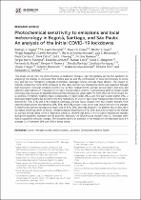Mostrar el registro sencillo del ítem
Photochemical sensitivity to emissions and local meteorology in Bogotá, Santiago, and São Paulo: An analysis of the initial COVID-19 lockdowns
| dc.contributor.author | Seguel, Rodrigo J. | |
| dc.contributor.author | Gallardo, Laura | |
| dc.contributor.author | Osses, Mauricio | |
| dc.contributor.author | Rojas, Néstor Y. | |
| dc.contributor.author | Nogueira, Thiago | |
| dc.contributor.author | Menares, Camilo | |
| dc.contributor.author | Andrade, Maria de Fatima | |
| dc.contributor.author | Belalcázar, Luis C. | |
| dc.contributor.author | Carrasco, Paula | |
| dc.contributor.author | Eskes, Henk | |
| dc.contributor.author | Fleming, Zoë L. | |
| dc.contributor.author | Huneeus, Nicolas | |
| dc.contributor.author | Ibarra-Espinosa, Sergio | |
| dc.contributor.author | Landulfo, Eduardo | |
| dc.contributor.author | Leiva, Manuel | |
| dc.contributor.author | Mangones, Sonia C. | |
| dc.contributor.author | Morais, Fernando G. | |
| dc.contributor.author | Moreira, Gregori A. | |
| dc.contributor.author | Pantoja, Nicolás | |
| dc.contributor.author | Parraguez, Santiago | |
| dc.contributor.author | Rojas Quincho, Jhojan Pool | |
| dc.contributor.author | Rondanelli, Roberto | |
| dc.contributor.author | Andrade, Izabel da Silva | |
| dc.contributor.author | Toro, Richard | |
| dc.contributor.author | Yoshida, Alexandre C. | |
| dc.date.accessioned | 2023-12-05T17:16:40Z | |
| dc.date.available | 2023-12-05T17:16:40Z | |
| dc.date.issued | 2022 | |
| dc.identifier.uri | https://hdl.handle.net/20.500.12542/3006 | |
| dc.description.abstract | This study delves into the photochemical atmospheric changes reported globally during the pandemic by analyzing the change in emissions from mobile sources and the contribution of local meteorology to ozone (O3) and particle formation in Bogotá (Colombia), Santiago (Chile), and São Paulo (Brazil). The impact of mobility reductions (50%–80%) produced by the early coronavirus-imposed lockdown was assessed through high-resolution vehicular emission inventories, surface measurements, aerosol optical depth and size, and satellite observations of tropospheric nitrogen dioxide (NO2) columns. A generalized additive model (GAM) technique was also used to separate the local meteorology and urban patterns from other drivers relevant for O3 and NO2 formation. Volatile organic compounds, nitrogen oxides (NOx), and fine particulate matter (PM2.5) decreased significantly due to motorized trip reductions. In situ nitrogen oxide median surface mixing ratios declined by 70%, 67%, and 67% in Bogotá, Santiago, and São Paulo, respectively. NO2 column medians from satellite observations decreased by 40%, 35%, and 47%, respectively, which was consistent with the changes in mobility and surface mixing ratio reductions of 34%, 25%, and 34%. However, the ambient NO2 to NOx ratio increased, denoting a shift of the O3 formation regime that led to a 51%, 36%, and 30% increase in the median O3 surface mixing ratios in the 3 respective cities. O3 showed high sensitivity to slight temperature changes during the pandemic lockdown period analyzed. However, the GAM results indicate that O3 increases were mainly caused by emission changes. The lockdown led to an increase in the median of the maximum daily 8-h average O3 of between 56% and 90% in these cities. | es_PE |
| dc.format | application/pdf | es_PE |
| dc.language.iso | spa | es_PE |
| dc.publisher | University of California Press | es_PE |
| dc.relation.uri | https://online.ucpress.edu/elementa/article/10/1/00044/169476/Photochemical-sensitivity-to-emissions-and-local | es_PE |
| dc.rights | info:eu-repo/semantics/openAccess | es_PE |
| dc.source | Repositorio Institucional - SENAMHI | es_PE |
| dc.source | Servicio Nacional de Meteorología e Hidrología del Perú | es_PE |
| dc.subject | Contaminantes Atmosféricos | es_PE |
| dc.subject | Pollutant Source | es_PE |
| dc.subject | Numerical Model | es_PE |
| dc.subject | Emission Inventory | es_PE |
| dc.title | Photochemical sensitivity to emissions and local meteorology in Bogotá, Santiago, and São Paulo: An analysis of the initial COVID-19 lockdowns | es_PE |
| dc.type | info:eu-repo/semantics/article | es_PE |
| dc.identifier.doi | https://doi.org/10.1525/elementa.2021.00044 | |
| dc.identifier.journal | Elementa: Ciencia del Antropoceno | es_PE |
| dc.subject.ocde | https://purl.org/pe-repo/ocde/ford#1.05.08 | es_PE |
| dc.subject.sinia | contaminacion del aire - Aire y Atmósfera | es_PE |
| dc.type.sinia | text/publicacion cientifica | es_PE |
| dc.identifier.url | https://hdl.handle.net/20.500.12542/3006 | |
| dc.identifier.url | https://hdl.handle.net/20.500.12542/3006 |
Ficheros en el ítem
Este ítem aparece en la(s) siguiente(s) colección(es)
-
Artículo científico [171]







